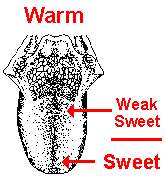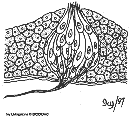 | Temperature and Taste Tangle on the Tongue |  |
 | Temperature and Taste Tangle on the Tongue |  |
| By Ellen Kuwana Neuroscience for Kids Staff Writer May 18, 2000
The Hot and Cold of TastingDoes hot have a taste? Does cold? "Yes," say researchers at Yale University. Their new study concludes that warming the tongue brings about a sweet taste and cooling the tongue results in a sour taste. Not only that, but heat or cold applied to the front of the tongue give slightly different results than when they are applied to the back of the tongue!
The ExperimentThe scientists changed the temperature of a small area (1 cm2) of the tongue in 24 people. The area was either warmed from 20oC to 25oC or chilled from 35oC to 15 or 5oC. These are within the range of temperatures for foods such as hot soup or ice cream. Four tests were performed: front/hot, front/cold, back/hot, and back/cold. Some people reported a taste for all four tests, others reported tastes for only some of the tests and others reported no taste for any of the tests.Study subjects reported that the front of the tongue tasted sweet when warmed and salty or sour when chilled. The back of the tongue tasted weakly sweet when warmed and sour or bitter when chilled. You may not have noticed this phenomenon because these sensations are faint, and are not obvious when you have a mouthful of food that has stronger flavors. |

|
The Taste Bud Image from Biodidac |
What's Going On?The receptors that sense taste and temperature reside close together in the mouth. Furthermore, nerve fibers that respond to sweet, sour, salty and bitter tastes are close to nerve fibers that detect temperature (as well as pain and pressure). Past research had suggested that many "taste" neurons also respond to temperature changes, but this study is the first to directly demonstrate the phenomenon. Thus, two distinct stimuli may bring about the same taste sensation. In this experiment, the stimuli are temperature and taste.
Getting to Know Your TongueThe sensory cells of your tongue are specialized epithelial cells called taste receptor cells. These cells are clustered in your taste buds, but are also found on the palate, pharynx, epiglottis and upper part of the esophagus. Receptor cells are regenerated every 10-14 days.The taste cells, when stimulated, release neurotransmitters onto sensory fibers that then send signals to the brain. These signals are integrated with olfactory (smell) information to give humans the perception of complex tastes. |
 |
|
Did you
know? |
Humans have approximately 10,000 taste buds.
|
|
References:
|
| BACK TO: | Neuroscience In The News | Table of Contents |
![[email]](./gif/menue.gif) Send E-mail | ![[survey]](./gif/menusur.gif) Fill out survey | ![[newsletter]](./gif/menunew.gif) Get Newsletter | ![[search]](./gif/menusea.gif) Search Pages | ![[notes]](./gif/menunot.gif) Take Notes |